
Concept explainers
Neopheliosyne B is a novel acetylenic fatty acid isolated from a New Caledonian marine sponge. (a) Label the most acidic H atom. (b) Which carbon-carbon
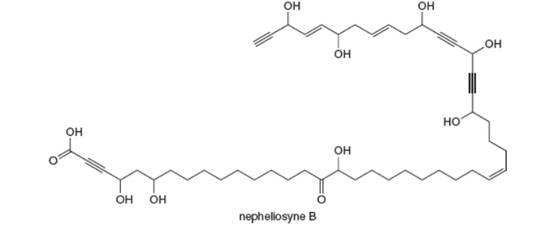
(a)
Interpretation: The most acidic H atom present in nepheliosyne B is to be labeled.
Concept introduction: The most acidic hydrogen
Answer to Problem 11.1P
The labeling of the most acidic H-atom present in nepheliosyne B is shown below.
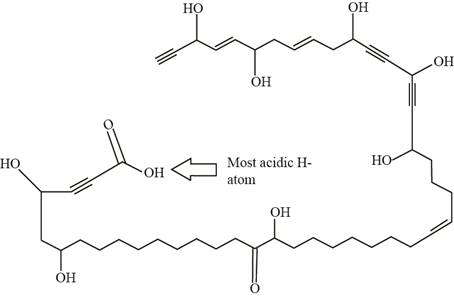
Explanation of Solution
The labeling of most acidic H-atom is shown as,
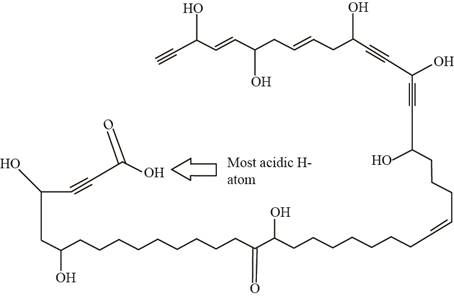
Figure 1
The stability of conjugate base of carboxylic acid is more than the stability of alcohol’s conjugate base. Thus, the acidity of hydrogen atom present in the carboxylic acid is more than that of alcohol because resonance stabilized conjugate base results in an increase in the acidity of a compound.
The labeling of most acidic H-atom present in nepheliosyne B is shown in Figure 1.
(b)
Interpretation: The shortest carbon-carbon
Concept introduction: The higher value of s-character corresponds to the higher electronegativity and lesser bond strength The highly electronegative carbon that is
Answer to Problem 11.1P
The shortest carbon-carbon
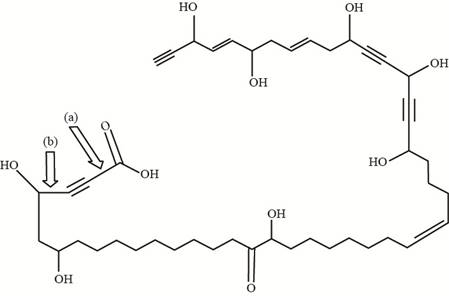
Explanation of Solution
The carbon-carbon

Figure 2
The bond (a) in the given compound is formed by
The shortest carbon-carbon
(c)
Interpretation: The number of degree of unsaturation contained by nepheliosyne B is to be stated.
Concept introduction: The degree of unsaturation states the total number of double bonds, triple bonds or rings present in a compound. It is calculated by the molecular formula of compound containing carbon and hydrogen atom.
Answer to Problem 11.1P
There are total
Explanation of Solution
The molecular formula of nepheliosyne B is given by,
Where
•
Substitute the value of
As the molecular formula of compound contains
The degree of unstauration is calculated by the formula,
Hence, the total number of degree of unstauration present in nepheliosyne B is
The total number of degree of unstauration present in nepheliosyne B is
(d)
Interpretation: The number of bonds formed by
Concept introduction: The procedure of intermixing of the atomic orbitals in an atom is known hybridization. This intermixing of the atomic orbitals is used to form a set of new atomic orbital with different geometry.
Answer to Problem 11.1P
The number of bonds formed by
Explanation of Solution
The number of bonds formed by
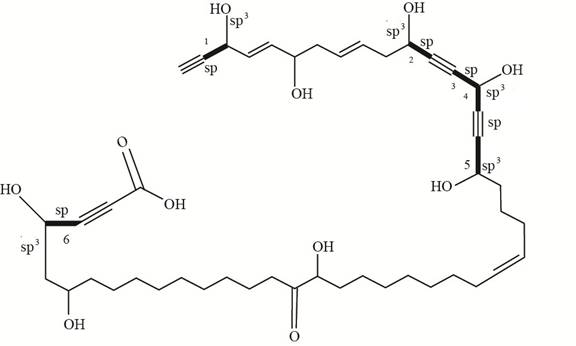
Figure 3
Thus, there are six bonds formed by
The total number of bonds formed by
(e)
Interpretation: Each of the triple bond present in nepheliosyne B is to be labeled as internal or terminal.
Concept introduction: The triple bond or alkyne which contains carbon substituents over acetylenic carbon is known as internal triple bond or alkyne. In case of terminal triple bond or alkyne, there is at least one acetylenic carbon that contains H-atom linked to it.
Answer to Problem 11.1P
The labeling of the triple bonds present in nepheliosyne B as internal or terminal is shown as,

Explanation of Solution
The labeling of the triple bonds present in nepheliosyne B as internal or terminal is shown as,

Figure 4
In Figure 4, there are three internal triple bonds and one terminal triple bond present.
The labeling of the triple bonds present in nepheliosyne B as internal or terminal is shown in Figure 4.
Want to see more full solutions like this?
Chapter 11 Solutions
ORGANIC CHEMISTRY W/CONNECT PKG
Additional Science Textbook Solutions
Inorganic Chemistry
Chemistry In Context
Chemistry & Chemical Reactivity
General Chemistry: Principles and Modern Applications (11th Edition)
- Name the following molecules, then rank their basicities in decreasing order (1 = most basic, 3 = least basic).arrow_forwarddentify the conjugate base in the reaction of propanoic acid CH3CH3COOH reacting with methyl amine, CH3NH2. a. CH3NH2 b. CH3CH3COOH c. CH3NH3+ d. OH-1 e. CH3CH3COO-1arrow_forwardAsteltoxin, isolated from cultures of Aspergillus stellatus, exhibits a potent inhibitor on E. coli BF1 ATPase activity. During S. L. Schreiber's synthesis of asteltoxin, substance 1 was treated with a strong base to form anion 2. a) Identify the most acidic proton at 1 and justify your choice using all the necessary representations.arrow_forward
- If compound A has a ka of 3.0 x 10-11 , compound B has a ka of 1.1 x 10-10 and compound C has a ka of 1.8 x 10-5, which compound is the weakest acid?arrow_forwardRank the following compounds (A-E) based on the acidity of the highlighted Hs (#1 most acidic; #5 least acidic)arrow_forwardThioglycolic acid, HSCH2CO2H, a substance used in depilatory agents (hair removers) has pKa = 3.42. What is the percent dissociation of thioglycolic acid in a buffer solution at pH = 3.0?arrow_forward
- Rank the following substances in order of increasing acidity: (a) (CH3)2CHOH, HC≡CH, (CF3)2CHOH, CH3OH (b) Phenol, p-methylphenol, p-[trifluoromethyl) phenol (c) Benzyl alcohol, phenol, p-hydroxybenzonic acidarrow_forwardDraw and name compounds that meet the following descriptions: (a) Three acid chlorides having the formula C6H9ClO (b) Three amides having the formula C7H11NOarrow_forwardWhy are terminal alkynes a lot more acidic than alkanes? - More hydrogen atoms on a sp^3 Carbon - C-C triple bond is stronger than a single bond - Sp1 Carbon in terminal alkynes stabilize conjugate bases. - none of the abovearrow_forward
- Give me handwritten answer? Complet rxnarrow_forward1.(a) Which of the following groups has the LOWEST IUPAC priority?(A) CH3 (B) NH2 (C) OH (D) COOH (E) Br (b)Which of the following corresponds to the strongest acid?(A) (CF3)3C-COOH (B) (CF3)3 C-OH(C) CH3COOH (D) CH3OH(E) HOCH2CH3arrow_forwardWhat is the conjugate acid of CH3O-? A) O2- B) H3O+ C) CH3OH D) OH⁻ E) none of the above Group of answer choices A B C D Earrow_forward

 Organic ChemistryChemistryISBN:9781305580350Author:William H. Brown, Brent L. Iverson, Eric Anslyn, Christopher S. FootePublisher:Cengage Learning
Organic ChemistryChemistryISBN:9781305580350Author:William H. Brown, Brent L. Iverson, Eric Anslyn, Christopher S. FootePublisher:Cengage Learning

